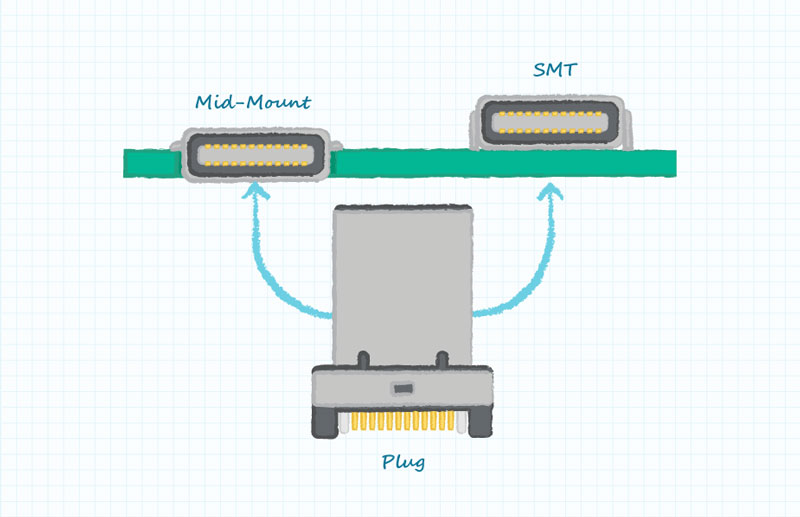USB Type-C: a look at data speeds, power delivery, and USB standards
Faster, Stronger, Higher said the Olympic motto: Faster, Smaller, Easier To Use could be an equivalent rallying cry for the electronics industry - and connectivity standards like USB in particular.
By Bruce Rose, Principal Applications Engineer, CUI Devices
You have probably seen new computing products in stores that feature the latest USB Type-C (USB-C) ports. Market analyst ABI Research identified 2017 as the 'tipping point' for USB-C adoption, so you may even have one on your desk already, and watch out for it in the side of your next ultra-low-profile Android phone: 830 million smartphones are predicted to ship with USB-C in 2021.
It certainly is smaller - the size being only about 9mm wide and 3.5mm high - and so enables equipment manufacturers to make their latest devices even smaller. The arrival of this new, smaller form factor is also perfectly timed to meet the needs of emerging product categories, such as home automation and IoT devices like smart sensors that simply do not have space for older, bulky connector styles.
Easier to use? Well, the cable can be inserted in either direction, and USB-C can even handle enough power for a device like a laptop, so there will be no need to carry around multiple cables for different purposes.
To support this extra versatility, the connector has become a lot more complex inside (figure 1). Firstly, there are more conductors. Compared with USB Type-A and Type-B connectors, which specified four or five conductors, the USB-C connector contains 24 contacts.
These are needed to allow bidirectional insertion, while supporting four power and ground pairs and two signal pairs. The durability rating is also increased to 10,000 insertions, compared to 1,500 for the older types.

Figure 1. The USB-C connector specification is more exacting than the earlier standards
The USB-C power and ground pairs are rated for voltages up to 20V and the current rating is also increased to give an overall rating of 5A. Hence a single USB-C connection can transfer power up to 100W.
Moreover, each of the data-pin pairs can handle data-transfer rates of up to 10Gbps, giving the connector a total aggregated capability of 20Gbps.
Not to be confused with the latest USB-IF data and power specifications
These significant increases in capability are needed to support the most recent data and power specifications released by the USB-IF, namely, the USB Power Delivery (USB PD), USB 3.1 Gen 2, and the recently-finalised USB 3.2 high speed data specifications:
- USB PD takes advantage of all four power and ground pairs to utilize the full 100W power-transfer capability of USB-C.
- USB 3.1 Gen 2 utilises one set of data lanes to define a transfer rate of 10Gbps.
- Similarly, USB 3.2 leverages both sets of 10Gbps data lanes to support transfers at up to 20Gbps.
It is important to separate, conceptually, the USB-C standard - which only defines the physical connection - from the USB PD and high-speed data (including USB 3.1 Gen 1 (SuperSpeed) and USB 3.1 Gen 2 (SuperSpeed +) as well as USB 3.2) specifications.
For example, although the USB-C connector is designed to support the USB PD standard, a USB PD compliant host controller is needed to negotiate and manage power delivery to connected devices. The cable must also be configured to support the standard. USB PD brings more than just an increase in power, it also enables bidirectional power delivery thereby giving users extra flexibility to power and charge their devices.
In addition, simultaneous power and data flow is now possible because USB PD performs power negotiation over the VBUS connection instead of using data connections. Table 1 shows how USB’s power-transfer capability has increased throughout recent generations.
Table 1. USB Power Delivery specifications
As far as the high speed data specifications are concerned, USB 3.1 Gen 2 defines the data and power signals but also does not specify the physical connection.
Thus, it is possible to connect USB 3.1 Gen 2 equipment communicating up to 10Gbps using legacy Type-A or Type-B connectors and cables - provided these have adequate current, voltage and signal-integrity characteristics.
Equally, USB-C connectors can be used to support legacy connection standards like USB 2.0, and simple hardware adapters are available.
Making connections
Clearly, not all USB-C connectors, or cable assemblies, will be created equally. Higher quality products will deliver greater performance, manifested as more reliable communication over longer cable lengths.
As well as considering the quality of the materials and USB-C connectors selected for forthcoming new products, designers can also choose from two versions of Type-C receptacles, as shown in figure 2. Standard SMT-mount receptacles are placed conventionally on top of the PCB. In this case, the total assembled height is the sum of the PCB thickness and the connector height.
Alternatively, the mid-mount connector type is designed to fit into a recess machined in the PCB. Although this permits a lower overall assembly height, the mid-mount type allows no opportunity to route signal traces under the connector.

Figure 2. SMT and mid-mount USB-C connectors
CUI Devices has a range of high quality USB Type-C plugs and receptacles in SMT and mid-mount types. The connectors are designed to support communication rates, as defined in USB 3.1 Gen 2 specifications, to serve designers’ needs both now and in the future.
Additional Resources
View more helpful USB connectivity resources and learn more about CUI Devices' comprehensive range of connectors, from Type-A to Type-C.
Read more helpful How To articles on Interconnect, Power, Audio, Thermal Management and Motion Control from the CUI Insights Blog.







